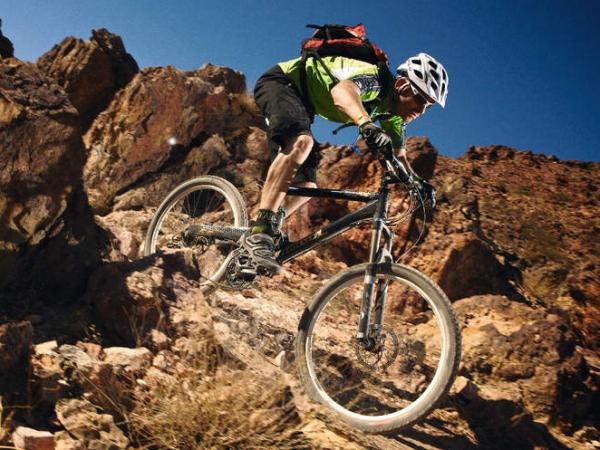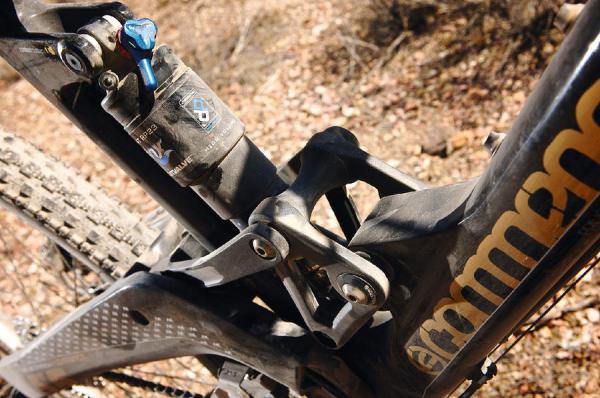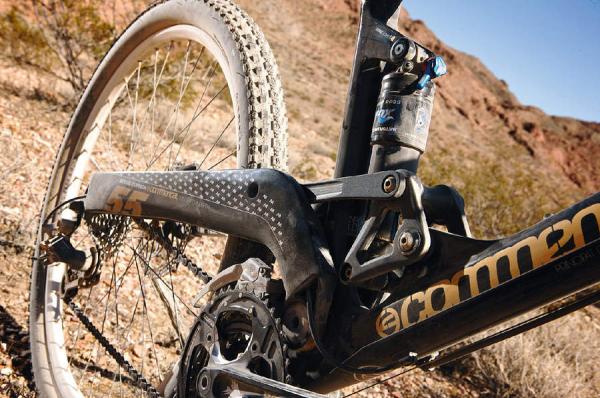You can trust Cyclingnews



Since Commencal introduced their Skin carbon hardtail earlier this year, we’ve been eagerly awaiting the arrival of fibrous frames in the Meta full-suspension range. While the 5.5's underlying geometry is unchanged, the new frame material makes a big difference to the ride.
While most companies seem to be using their carbon frames to extort as much money as possible, Commencal’s bike has definitely impressed us. The frame price might be expensive but the complete bike is actually good value.
Going carbon provides very obvious ride advantages in terms of weight and rear end stiffness. It’s not the stiffest or lightest bike in its category, but it is stiff and light enough to put it back in the mix as an enjoyable all-day bike. In typical Commencal style, it’s one that thrives in more challenging, technical situations too.
Ride & handling: A real blast on technical singletrack and descents
At under 27lb for our large sample, the Meta is still heavy compared with the lightest 140/150mm bikes from Specialized and Scott, but it’s definitely light in terms of all-mountain style bikes. Even though the Meta is steeper than it used to be (pre-2009) in terms of handling angles, we’d still definitely place it in this more playful category too.
Keep the shock with around 25 percent sag and it leans back into the trail, begging to be carved and chucked around from lip to berm. While it’s not as ‘chaos situation’ confident as the older, slacker bikes which lairy riders loved, the steeper angles keep the head down for a more reliable line on climbs.
There’s less emphasis on moving your body weight around a lot to lock down traction too, so less experienced riders will find a balanced and friendly ride rather than hair-trigger responsiveness.
The semi-slick rear tyre means it oversteers amusingly rather than understeering threateningly if you push it too hard. It helps the Meta pick up speed smartly enough and holds it well too.
The Contact System pushlink and rocker suspension architecture is unchanged but feels even better with the new shock. It was always a surprisingly stable pedaller, but now it sits totally flat even when you’re cranking hard.
Start clobbering stuff though, and the shock is consistently controlled throughout the bump range. The Boost Valve pressure damping means it never over-travels or wallows, and it collects big drops calmly without a clunk or buckaroo rebound.
Even with a quick-release axle, rather than Maxle screw-through, the carbon fibre rear end is far stiffer than the old alloy one too. There’s a much more positive response when you stamp on the pedals and no obvious sideways ‘sawing’ of the swingarm even when big blokes were giving it some grunt.
It also gives a much more accurate carving and cornering feel, so you can control the often wayward rear tyre easily. This rear stiffness does make the flex from the standard head tube/thin top tube mainframe more obvious when you’re really shoving it through corners, though.
The overall handling balance means it only ever breaks out into a controllable, smile-inducing smear rather than a sudden twang off line. The super-accurate damping and stiffer tracking from the 140mm (rather than 150mm) version of the fork also helps keep its nose clean when the trail gets snotty.
Frame: Carbon good looks and stiffer rear end are recipe for success
The first show samples we saw of the Meta Carbon had a carbon mainframe but retained an alloy swingarm; the production bikes have a complete carbon fibre structure, however.
Unlike most manufacturers, Commencal are staying with a non-tapered fork steerer and head tube for 2010. It’s a low profile integrated unit, and an extended web reinforces the top and down tube junction. The top shock mount and seat tube buttress all sit in a single mass at the far end of the tall, narrow top tube.
The seat tube bottoms onto the main pivot rather than the bottom bracket, with a vestigial seat tube stub to hold the front mech. You only get ISCG mounts on the longer travel Meta 6, however. The slab-sided symmetrical swingarms curve upwards from the main pivot for chain clearance.
Looking from above, the keyhole profile and full depth curved brace plate offer reasonable mud room. Commencal also retain the internal gear cable routing on the driveside, while the disc brake hose clips onto the top of the offside stay.
The same carbon swingarm is used on the alloy mainframe Meta 5.5 Limited model, while cheaper 2010 Meta frames get the interchangeable dropouts on an alloy swingarm.
Equipment: Tough but light kit that suits the frame perfectly without breaking the bank
Commencal only produce one complete bike on the carbon frame and it’s equipped to showcase the new chassis well without being insanely expensive. Fox provide the latest FIT damping cartridge version of their Float 140mm travel fork complete with 15mm screw-through axle.
This syncs with Shimano XT hubs on okay but not outstanding custom-coloured DT rims. The tyre mix of grippy Maxxis High Roller front and fast but drifty CrossMark rear is a great one for fast, aggressive riding in drier conditions though.
All this is driven by a purposeful-feeling SRAM, Shimano and Race Face pick ‘n’ mix transmission selection that’s suitably tough but light to match the bike. While their major advantage is minimal weight, the Formula R1 brakes don’t skimp on power or control either.
Race Face also supply the short Deus stem that holds the usefully wide Easton bars. SDG’s impressively light and tough but relatively rare I-Beam combo supplies the seating equipment.
We’ve no real complaints about this spec (apart from, perhaps, the rims) but if you want to transfer your own bits or build from scratch the ‘VIP’ carbon frame is available for £2,000. You can also buy a frame ‘kit’ with custom colour bar, stem, post and fork for £2,699 – which makes the whole bike look pretty reasonable.